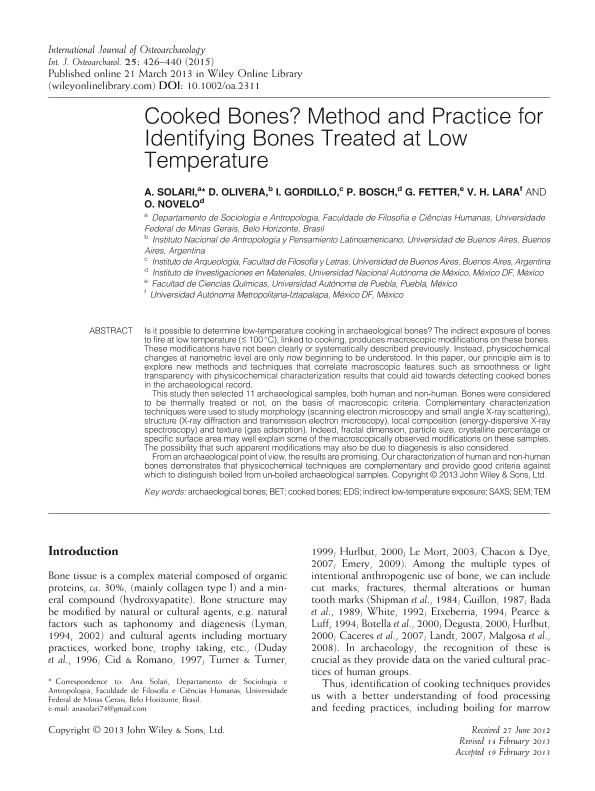Mostrar el registro sencillo del ítem
dc.contributor.author
Solari, Ana
dc.contributor.author
Olivera, Daniel Enzo

dc.contributor.author
Gordillo, Ines Graciela

dc.contributor.author
Bosch, P.
dc.contributor.author
Fetter, G.
dc.contributor.author
Lara, V. H.
dc.contributor.author
Novelo, O.
dc.date.available
2017-10-02T19:41:54Z
dc.date.issued
2013-03
dc.identifier.citation
Solari, Ana ; Olivera, Daniel Enzo; Gordillo, Ines Graciela; Bosch, P.; Fetter, G.; et al.; Cooked bones? method and practice for identifying bones treated at low temperature; Wiley; International Journal of Osteoarchaeology; 25; 4; 3-2013; 426-440
dc.identifier.issn
1099-1212
dc.identifier.uri
http://hdl.handle.net/11336/25680
dc.description.abstract
Is it possible to determine low-temperature cooking in archaeological bones? The indirect exposure of bones to fire at low temperature (≤ 100 °C), linked to cooking, produces macroscopic modifications on these bones. These modifications have not been clearly or systematically described previously. Instead, physicochemical changes at nanometric level are only now beginning to be understood. In this paper, our principle aim is to explore new methods and techniques that correlate macroscopic features such as smoothness or light transparency with physicochemical characterization results that could aid towards detecting cooked bones in the archaeological record. This study then selected 11 archaeological samples, both human and non-human. Bones were considered to be thermally treated or not, on the basis of macroscopic criteria. Complementary characterization techniques were used to study morphology (scanning electron microscopy and small angle X-ray scattering), structure (X-ray diffraction and transmission electron microscopy), local composition (energy-dispersive X-ray spectroscopy) and texture (gas adsorption). Indeed, fractal dimension, particle size, crystalline percentage or specific surface area may well explain some of the macroscopically observed modifications on these samples. The possibility that such apparent modifications may also be due to diagenesis is also considered. From an archaeological point of view, the results are promising. Our characterization of human and non-human bones demonstrates that physicochemical techniques are complementary and provide good criteria against which to distinguish boiled from un-boiled archaeological samples.
dc.format
application/pdf
dc.language.iso
eng
dc.publisher
Wiley

dc.rights
info:eu-repo/semantics/openAccess
dc.rights.uri
https://creativecommons.org/licenses/by-nc-sa/2.5/ar/
dc.subject
Archaelogical Bones
dc.subject
Bet
dc.subject
Cooked Bones
dc.subject
Indirect Low Temperature Exposure
dc.subject
Eds
dc.subject
Saxs
dc.subject
Sem
dc.subject
Tem
dc.subject.classification
Arqueología

dc.subject.classification
Historia y Arqueología

dc.subject.classification
HUMANIDADES

dc.title
Cooked bones? method and practice for identifying bones treated at low temperature
dc.type
info:eu-repo/semantics/article
dc.type
info:ar-repo/semantics/artículo
dc.type
info:eu-repo/semantics/publishedVersion
dc.date.updated
2017-10-02T19:10:25Z
dc.journal.volume
25
dc.journal.number
4
dc.journal.pagination
426-440
dc.journal.pais
Estados Unidos

dc.journal.ciudad
Hoboken
dc.description.fil
Fil: Solari, Ana. Universidade Federal Do Minas Gerais. Departamento de Sociología y Antropología; Brasil
dc.description.fil
Fil: Olivera, Daniel Enzo. Consejo Nacional de Investigaciones Científicas y Técnicas; Argentina. Secretaría de Cultura de la Nación. Dirección Nacional de Cultura y Museos. Instituto Nacional de Antropología y Pensamiento Latinoamericano; Argentina. Universidad de Buenos Aires; Argentina
dc.description.fil
Fil: Gordillo, Ines Graciela. Universidad de Buenos Aires. Facultad de Filosofía y Letras. Instituto de Arqueología; Argentina
dc.description.fil
Fil: Bosch, P.. Universidad Nacional Autónoma de México; México
dc.description.fil
Fil: Fetter, G.. Universidad Autónoma de Puebla; México
dc.description.fil
Fil: Lara, V. H.. Universidad Autónoma Metropolitana-Iztapalapa; México
dc.description.fil
Fil: Novelo, O.. Universidad Nacional Autónoma de México; México
dc.journal.title
International Journal of Osteoarchaeology
dc.relation.alternativeid
info:eu-repo/semantics/altIdentifier/url/http://onlinelibrary.wiley.com/doi/10.1002/oa.2311/full
dc.relation.alternativeid
info:eu-repo/semantics/altIdentifier/doi/http://dx.doi.org/10.1002/oa.2311
Archivos asociados
